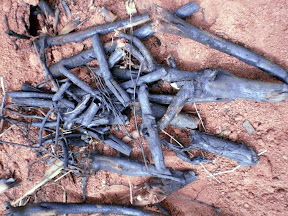This is the simplest and convenient method for farmers to convert the crop residue / biomass in the farm lands into Biochar. 'Biochar Trenches' / 'Staggered Biochar trenches' of 2 to 3 feet depth and 1.5 to 2 feet width could be made using simple tools in a agriculture fields. (deeper trenches can also be made) It is more convenient to make such trenches after ploughing the field. Trenches perpendicular to the slopes also benefit the steep sloppy areas as water harvesting means. All the crop residue otherwise burnt openly can be collected and dumped into these trenches lengthwise. More biomass can be added by pushing it with a stick. Once the trench is filled with biomass and compact, should be covered by grass / weeds / broad leaves / etc. After covering it up, soil should be spread on the trench, a lengthy mound is created. Some water could be used to make the soil compact and for sealing the mound of biomass. A small hole is left open for lighting the biomass at one end and at the other end a very small opening is left open. Once it is lit, white smoke starts emitting at the other end. Small holes to be made in a biochar lenghty trench at every 10 to 15 feet in a biochar trench and light it. Or one could create staggered trenches of 10 to 15 feet in length instead of lengthy single trenches. After 24 hours the biomass is converted into biochar, also one could see that the mound height also reduces. Any little smoke or embers should be quenched with water or covered with soil while removing the biochar from the trench.
In the forest and hilly areas, the staggered trenches or continuous contour trenches prepared for management of soil and water harvesting, could be used for management of litter on the forest floors by converting into the biochar as well preventing forest fires.
The major benefits of this method is:
- Convenient for farmers otherwise just burning biomass openly and also causing pollution.
- In open burning mostly the biomass converts in ash and little charcoal is formed.
- In the process soil also get burnt, the burnt soil is good for soil like the pottery shards.
- All the biochar, burnt soil remains within the soil / field, which could be conveniently spread by the farmer within the whole field.
- The farmer need not transport the biomass to any other place for conversion into biochar.
- Farmer need to invest on technologies and have licences for converting biomass into biochar.
- Most convenient for small and marginal farmers.
This method was introduced by Dr. N. Sai Bhaskar Reddy, GEO to farmers Good Stoves and Biochar Communities Project {GSBC}, Supported by GoodPlanet.org



















